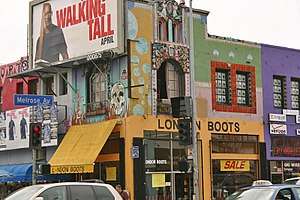Melrose Avenue
Melrose Avenue is a shopping, dining and entertainment destination in Los Angeles that starts at Santa Monica Boulevard, at the border between Beverly Hills and West Hollywood. It ends at Lucile Avenue in Silver Lake. Melrose runs north of Beverly Boulevard and south of Santa Monica Boulevard.

Paved in 1909, Melrose Avenue's namesake comes from the Massachusetts town of the same name.[1]
Its most famous section, known as the Melrose District, is the West End through West Hollywood and Hollywood.
At the corner of Fairfax and Melrose is Fairfax High School, which marks the start of the Fairfax District.
One of the most famous landmarks located on Melrose Avenue is Paramount Pictures.
Metro Local line 10 operates on Melrose Avenue.
Melrose District
The eastern end of the district, which runs from Fairfax to Highland Avenue, became a popular underground and new wave shopping area in the early 1980s. Pioneered by adventurous independent retailers and restaurateurs, Melrose Avenue captured the global imagination as the birthplace of Southern California's New Wave and Punk cultures. Rapid notoriety quickly lured movie stars, moguls, and style seekers, leading the press to dub Melrose Avenue "the new Rodeo Drive." Ready for its close-up, the avenue enjoyed its share of TV and movie cameos, and appeared regularly on Jay Leno's "Jaywalking" segments of The Tonight Show With Jay Leno, in addition to shows such as Entourage and LA Ink.
Melrose District got its notoriety in Aaron Spelling's 1990s soap opera on the Fox network Melrose Place.
As a constantly evolving merchant district, it has featured stores such as Vinyl Fetish, Harvey's On Melrose Golden Girls Rattan Furniture and Retail Slut, They all closed several years ago, Harvey's has made a comeback after 20 years but on Beverly the new Melrose while The Burger That Ate L.A., a landmark fast food stand, was in recent years replaced with a Starbucks. The original Johnny Rockets opened in this end of Melrose in 1986. Long-term stakeholders like The Groundlings, l.a.Eyeworks, Angeli Caffe and Sportie LA have shown continued dedication to the community. In 2005, musician and director Joe Hahn, member of the rock band Linkin Park, opened his concept retail store SURU on the 7600 block of Melrose. Canadian designer John Fluevog opened on Melrose in 2003. As one of the city's most walking-friendly neighborhoods, this must-see destination has maintained its reputation for an original, alternative and independent experience for more than three decades.
Since 1997, the Melrose Trading Post outdoor flea market has created opportunities for Fairfax High School and the surrounding neighborhood. Every Sunday 250+ local vendors, collectors, artisans, and artists gather in the parking lot on the corner of Melrose and Fairfax Avenues to celebrate the thriving community culture. Food vendors and live music round out this weekly local event hosted by the Greenway Arts Alliance. Money raised by this nonprofit organization from the low-cost patron admission and vendor booth fees fuel a thriving arts education program on the FHS campus called, Institute for the Arts at Greenway.

At the corner of Highland and Melrose is what has been described by the Los Angeles Times as the "boss of LA's Italian dining scene", Osteria Mozza (See Los Angeles Times, Thursday, August 7, 2007, pg. E46), which marks the eastern end of the Fairfax District.
The Melrose Business Improvement District (Melrose BID) Association is tasked with working to enhance the commercial vitality of Melrose Avenue between Highland and Fairfax Avenues by providing improvements and activities throughout the district.
Melrose Heights
The Western End, popularly referred to as Melrose Heights, runs from La Cienega Blvd. to Fairfax Avenue and features a variety of upscale restaurants, boutiques such as the Kardashian sisters boutique D-A-S-H and salons such as Elixir (teahouse), The Bodhi Tree Bookstore (metaphysical and New Age books), Fred Segal, Plush Home, and The Improv. Melrose Heights is also home to several high-end designer stores, such as Marc Jacobs, Diane von Fürstenberg, Carolina Herrera, Mulberry, Sergio Rossi, Alexander McQueen, Oscar de la Renta, BCBG Max Azria, Paul Smith, Temperley London, John Varvatos, Balenciaga, Diesel, Vivienne Westwood and Vera Wang.
Melrose Place
North of the intersection with La Cienega Boulevard is Melrose Place, a branch of the main avenue made famous thanks to the soap opera of the same name. In reality, Melrose Place features no residences and has historically been home to antique shops, boutiques and salons.
La Cienega Design Quarter
The area of Melrose Avenue that intersects La Cienega Boulevard and its satellite streets is part of the La Cienega Design Quarter. Its shops and galleries house many antiques, furniture, rugs, accessories and art.
References
- Melrose Avenue Official Guide
- Melrose Avenue Merchant Alliance (MAMA)
- Huffington Post - October 8 2010
Music Video by Bobby Valentino performing 'Slow Down'